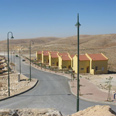
West Bank settlement
צילום: תצפית צילומי אויר
Study: Settlements depend heavily on government funding
Israeli government allocates 4.1% of its total budget for municipalities to settlements although they constitute just 3.1% of total population,' Macro Center report says. Director: Settlements distort priorities of government's decision-making process
Jewish settlements in the occupied West Bank get significantly bigger slice of Israeli government financial help than municipalities in Israel itself, according to a study published on Tuesday.
Their population is also growing more than three times faster than that of the population within the Green Line, says the report, which traces the development of Jewish settlements since the 1967 Middle East war to today.
The United States is calling on Israel to freeze all settlement activity so that stalled talks can resume with the Palestinians on a comprehensive peace deal that would determine the fate of settlements in a land-for-peace swap.
"While Israeli municipalities as a whole receive 34.7 % of their income from (the government) and obtain another 64.3% from their own income, settlement municipalities obtain 57 % from the (government), and only 42.8% from their own income," it found.
Israel's government "allocates 4.1% of its total budget for municipalities to settlements, although they constitute just 3.1% of the total Israeli population," the report adds.
The study by the Macro Center of the Israeli European Policy Network is entitled "Historical Political and Economic Impact of Jewish Settlements in the Occupied Territories."
'Active support of all Israeli governments'
It assesses the value of all buildings in the settlements, some of them commuter communities with no industry on-site to provide a significant source of revenue, at about $18 billion.
"Not only do settlements distort priorities of the Israeli government's decision-making process on economic, political and social issues -- the government of Israel proactively funds more than half of their existence too," said director Roby Nathanson.
The study's analysis shows that the hey-day of settlement construction was between 1977 and 1983, under the late Prime Minister Menachem Begin, when more than 56% of settlements were built.
"Settlement activity declined dramatically after 1985," it states. In the first decade after 1967 it was limited to areas of sparse Palestinian population but later spread to areas of dense Palestinian settlement.
The bulk of construction is residential, mostly three to four-room dwellings. The total Jewish population reached 276,045 by the end of 2007 and at median age of 20 it is the youngest of any segment of the Israeli population.
"In the past 20 years, despite ongoing peace negotiations, the population of settlers in the West Bank has more than doubled, at a growth rate much higher than that of the general Israeli population," says the report.
"This increase could not have been achieved without the active support of all of the Israeli governments in this period."










